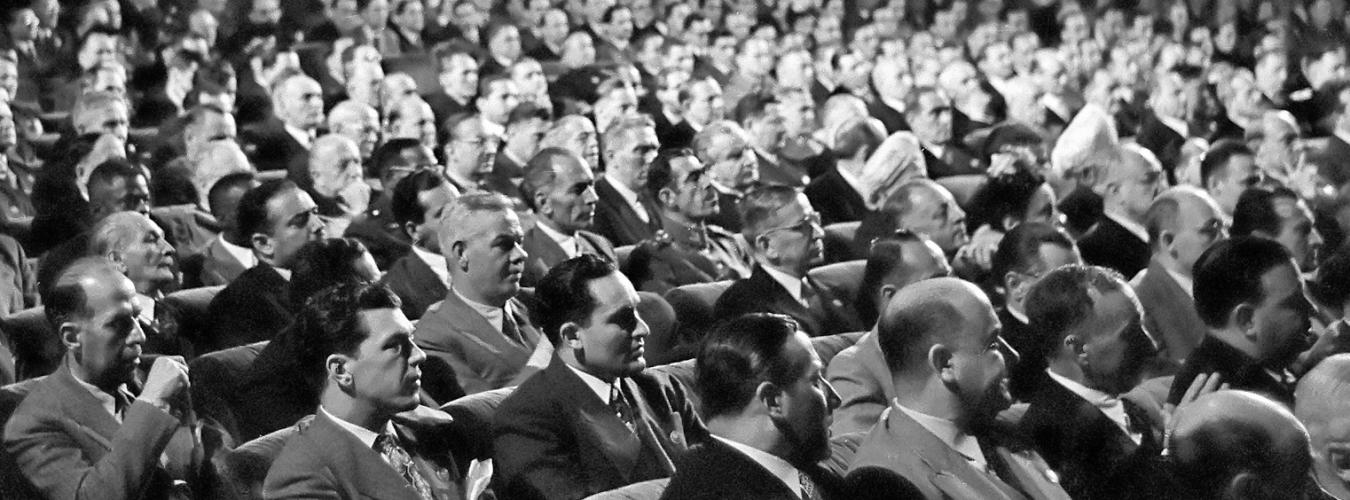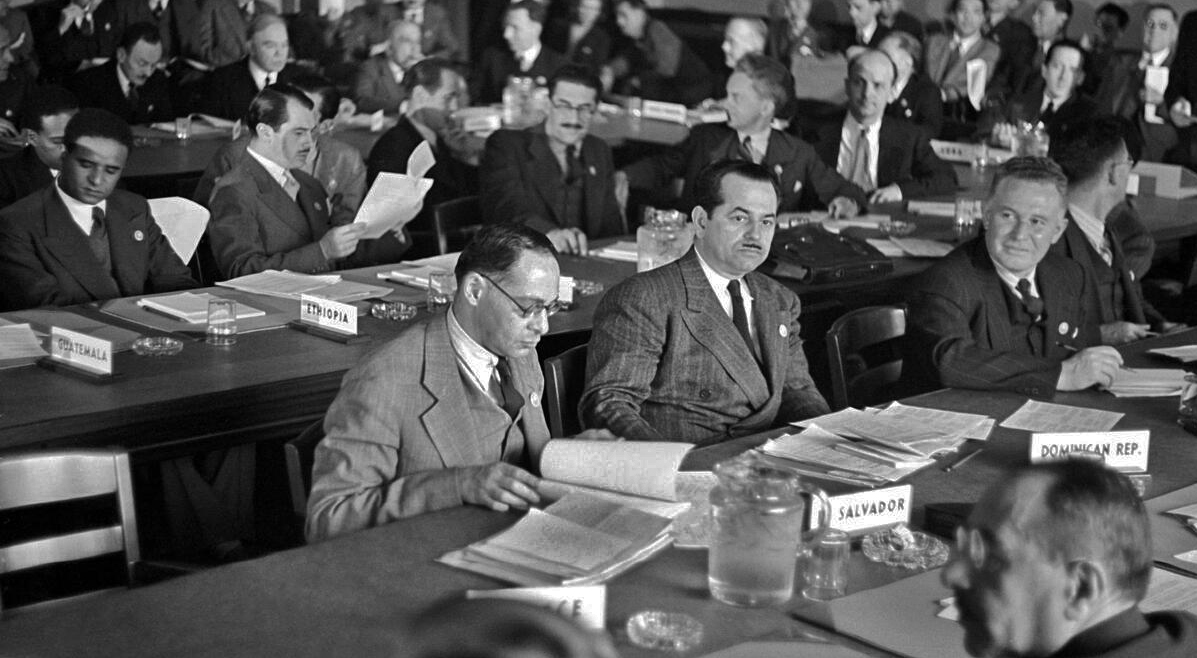
Delegates of fifty nations met in San Francisco, California, USA, between 25 April and 26 June 1945 at the United Nations Conference on International Organization. Working on the Dumbarton Oaks proposals, the Yalta Agreement, and amendments proposed by various governments, the Conference agreed upon the Charter of the United Nations and the Statute of the new International Court of Justice.
Forty-six nations, including the four sponsors, were originally invited to the San Francisco Conference. These were the nations which had declared war on Germany and Japan and had subscribed to the United Nations Declaration. One of these nations - Poland - did not send a representative because the composition of its new government was not announced until too late for the conference. Therefore, a space was left for the signature of Poland, one of the original signatories of the United Nations Declaration. At the time of the conference there was no generally recognized Polish Government, but on 28 June such a government was announced and on 15 October 1945, Poland signed the Charter, thus becoming one of the original 51 Members. The conference itself invited four other states - the Byelorussian Soviet Socialist Republic, the Ukrainian Soviet Socialist Republic, newly-liberated Denmark and Argentina. Thus delegates of fifty nations in all, gathered at the San Francisco Conference in April 1945.
A documentary on the San Francisco Conference and the signing of the United Nations Charter
Four Committees and Four Commissions
The work of the San Francisco Conference was organized as follows. The highest body was the Conference in Plenary Session, which was in charge of the final voting and adoption of the text. Below the plenary, four committees were established:
- the Steering Committee, composed of the chairmen of all delegations, which considered major questions of policy and procedure;
- the Executive Committee, composed of the chairmen of 14 delegations (those of the four sponsoring Governments and ten co-elected members), serving the Steering Committee by preparing recommendations for its consideration;
- the Coordination Committee, composed of technical members of the same 14 delegations, which assisted the Executive Committee and was itself assisted by an Advisory Committee of Jurists;
- the Credentials Committee, formed by representatives from six delegations, verifying the credentials of delegates.

Steering Committee Meeting on 10 May 1945 in San Francisco. Center table, left to right: Bitwodded Makonnen Endalkachau, Ethiopia; Camilo Ponce Enriquez, Ecuador; and adviser. UN Photo/Eastman
Below this level, the study of the most important issues to be settled was divided among four general commissions, which coordinated the work of twelve technical committees, charged with the preparation of drafting proposals; when needed, the technical committees could designate sub-committees. The work was organized as follows:
- Commission I (General Provisions) coordinated the work of Technical Committee 1 (Preamble, Purposes and Principles) and Technical Committee 2 (Membership, Amendment and Secretariat);
- Commission II (General Assembly) coordinated the work of Technical Committee 1 (Structure and Procedures), Technical Committee 2 (Political and Security Functions), Technical Committee 3 (Economic and Social Cooperation) and Technical Committee 4 (Trusteeship System);
- Commission III (Security Council), coordinated the work of Technical Committee 1 (Structure and Procedures), Technical Committee 2 (Peaceful Settlement), Technical Committee 3 (Enforcement Arrangements) and Technical Committee 4 (Regional Arrangements);
- Commission IV (Judicial Organization), coordinated the work of Technical Committee 1 (International Court of Justice) and Technical Committee 2 (Legal Problems).
A Secretariat provided general administration to the Conference. On the side of this official structure, informal consultations were held among delegations, most notably among the five principal powers at the Conference (the United States, the United Kingdom, the USSR, China and France). More than five thousand documents were considered at the Conference: a compilation of the principal documents was published under the title Documents of the United Nations Conference on International Organization, San Francisco, Volumes I to XX, 1945-1954.
The Charter of the United Nations, together with the Statute of the International Court of Justice which forms an integral part of the Charter, was adopted unanimously at the end of the Conference, on 25 June 1945 at the San Francisco Opera House, and was signed the following day at the Herbst Theatre auditorium of the Veterans War Memorial Building. It entered into force, in accordance with its Article 110, paragraph 3, on 24 October 1945, following the deposit of the instruments of ratification of the five permanent members of the Security Council and a majority of all other signatories.
Delegates and Staff in the Thousands
There were 850 delegates at the Conference, and their advisers and staff together with the conference secretariat brought the total to 3,500. In addition, there were more than 2,500 press, radio and newsreel representatives and observers from many societies and organizations. In all, the San Francisco Conference was not only one of the most important in history but, perhaps, the largest international gathering ever to take place. The heads of the delegations of the sponsoring countries took turns as chairman of the plenary meetings : Anthony Eden, of Britain, Edward Stettinius, of the United States, T. V. Soong, of China, and Vyacheslav Molotov, of the Soviet Union. At the later meetings, Lord Halifax deputized for Mr. Eden, V. K. Wellington Koo for T. V. Soong, and Mr Gromyko for Mr. Molotov.
Plenary meetings are, however, only the final stages at such conferences. A great deal of work has to be done in preparatory committees before a proposition reaches the full gathering in the form in which it should be voted upon. And the voting procedure at San Francisco was important. Every part of the Charter had to be and was passed by a two-thirds majority. This is the way in which the San Francisco Conference got through its monumental work in exactly two months.
UN Radio Classics | Listen to "A GREAT DAY" a programme recalling June 26, 1945, the day the United Nations Charter was signed.
The Charter is approved
The United Nations did not come into existence at the signing of the Charter. In many countries the Charter had to be approved by their congresses or parliaments. It had therefore been provided that the Charter would come into force when the Governments of China, France, Great Britain, the Soviet Union and the United States and a majority of the other signatory states had ratified it and deposited notification to this effect with the State Department of the United States. On 24 October 1945 (now observed annually as United Nations Day) this condition was fulfilled and the United Nations came into existence. Four years of planning and the hope of many years had materialized in an international organization designed to end war and promote peace, justice and better living for all mankind.
UN Radio Classics | Listen to the British actor Sir Laurence Olivier as he reads the Preamble to the Charter of the United Nations. The Charter was signed at the San Francisco Conference on 26 June 1945. Music by American composer Aaron Copland.
